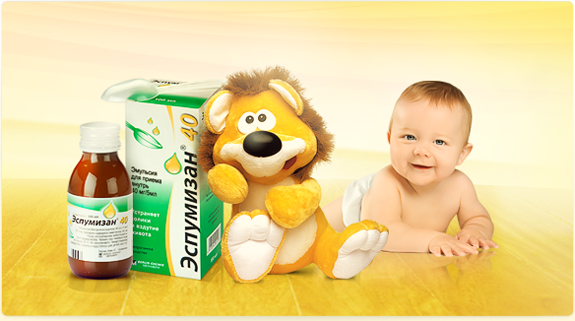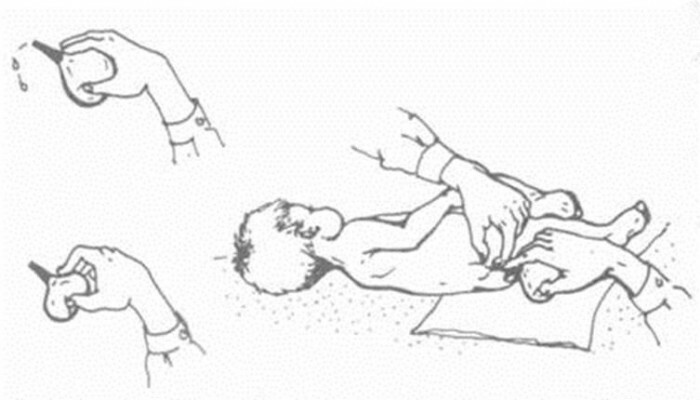Colic in the newborn
 Colic in newborns is an unpleasant, but quite normal and often occurring phenomenon.It is characterized by severe pain in the abdomen of the baby, but does not pose a serious danger.To date, doctors have not been able to pinpoint the cause of their development.
Colic in newborns is an unpleasant, but quite normal and often occurring phenomenon.It is characterized by severe pain in the abdomen of the baby, but does not pose a serious danger.To date, doctors have not been able to pinpoint the cause of their development.
Unfortunately, none of the drugs can not be guaranteed to stop this phenomenon.
Reliably established that with the passage of time colic in babies are spontaneous.It is believed that these periodically arising pains are one of the main causes of restless behavior of young children.
As a rule, this problem develops in a newborn, starting from the 3rd week of life.By the age of three months, colic usually ceases.
Table of Contents:Causes of colic in infants
Some of the causes of colic in infants are considered by some specialists to be general underdevelopment of the digestive tract( especially intestines) in children immediately after birth.But this theory does not allow us to explain the nature of the pain in toddlers a little older, whose digestive tract has already gotten stronger.
The version according to which the problem is in the air that enters the baby's stomach during feeding and crying is quite reliable.It is believed that it causes the expansion of the walls of the digestive tract, which leads to the development of an intense pain syndrome.Therefore, it is necessary to try to avoid the wrong technique of feeding, in which the baby does not completely grasp the mother's nipple with her lips, and the child-the "artificial" - bottle bottle.It is in such cases that a significant amount of air enters the stomach and intestines.
 Note: colic in newborns usually lasts one and a half to two hours, and in an older child( 2-3 months) they end later - after three to four hours.
Note: colic in newborns usually lasts one and a half to two hours, and in an older child( 2-3 months) they end later - after three to four hours.
If, at the end of feeding, the newborn is not allowed to belch out excess air, it can also cause intense colic.
Recommended to read:To the painful condition, too often leads and an excessively long time of being in a horizontal position, which makes digestion difficult, and in particular, the escape of gases.Although the baby of the first months of life does not consume dense food, his intestine is not absolutely empty.Passage of food and air masses through the digestive tract is greatly facilitated when the child is held vertically, since one can not discount the important factor, such as gravity.
If the child is a lot and often screams for colic, the vicious circle generally closes, as during the crying the baby swallows more and more air and the pain is further intensified.
Colic may well be associated with overfeed.If there is more food in the intestine of the baby than it is able to digest, then due to a lack of digestive enzymes, its excess is fermented and increased gas formation occurs.Gases press on the intestinal walls and develop colic.
There is an opinion that the problem can be caused by congenital lactase deficiency.But this problem occurs in 1 case for 130 thousand babies, and colic disturbs 70% of newborns.In addition, nutrition with artificial lactose-free mixtures does not reduce the likelihood of intestinal colic development.
The theory that explains colic dysbacteriosis, also does not stand up to criticism.In infancy, no one in the digestive tract can have a stable microbiocenosis, but not all suffer from the pain in the abdomen.
Symptoms of colic in newborns
 Since the newborn can not explain what exactly is bothering him, only indirect symptoms can indicate the development of colic in him.
Since the newborn can not explain what exactly is bothering him, only indirect symptoms can indicate the development of colic in him.
About intestinal colic with a high degree of probability speak loud and prolonged cry and crying of the baby.The child begins to cry suddenly and just as suddenly calms down.If the crying lasts longer than a few hours, then probably the reason is completely different.
Many newborns have colic in fact "by the hour."They begin about 20-30 minutes after the end of feeding and continue depending on the age of 1.5 to 4 hours.
Some babies also have some additional symptoms, including:
- abdominal legs;
- redness of the face;
- slight bloating;
- slight deflection in the back.
Treatment of colic in newborns
Important: only the district pediatrician can diagnose "intestinal colic".Kolika belongs to the so-called."Diagnosis of exclusion".To a similar conclusion, a specialist can come only if other causes of crying and restless behavior of the baby( constipation, diathesis, etc.) are not detected.
What can I do if a newborn has colic?
General recommendations for the treatment of colic in newborns
The list of general recommendations includes the following tips:
- Ensure that the baby correctly grasps the nipple when feeding.
- Try not to overfeed your baby, and after a meal hold his belly down( at an angle of 45 °) to allow you to belch excess air or put on your hands in a "post" for 10 minutes.
-
 During an attack of intestinal colic, place the babe on your tummy on a warm folded diaper several times or simply apply a diaper, ironed with a hot iron, to the tummy of the baby.
During an attack of intestinal colic, place the babe on your tummy on a warm folded diaper several times or simply apply a diaper, ironed with a hot iron, to the tummy of the baby. - Do gymnastics!For the treatment of colic and pain relief, gently bring the legs of the newborn to the stomach several times - this will allow the intestines to free themselves of the gases.
- Often take babies in your arms - let it stay in the upright position for as long as possible.
- After 30-40 minutes after the next feeding, stroke the baby through the tummy( the direction of movements is clockwise).This light massage will improve the intestinal motility and prevent the accumulation of gases.
- Use medicines
Maternal diet to prevent colic in newborns
It is recommended that breastfeeding mothers follow a diet that excludes from the diet products that cause the formation of gases in the intestines of the baby.
Products that provoke increased gas production:
- whole milk( it is better to replace it with fermented milk products);
- rye bread;
- bread made from wheat flour;
- leguminous crops( beans, peas, soybeans, beans);
- raw and pickled vegetables;
- fresh fruit;
- Other foods rich in fiber.
Read more about the diet recommended during lactation on our website.
Reliable remedy for colic, unfortunately, has not yet been invented.The famous pediatrician Komarovsky believes that colic treats only time and parental patience.
Child "artificial" is recommended to purchase a milk bottle with a tube for air removal.This design minimizes the ingestion of air.
Medication for colic in newborns
If colic attacks can not be suppressed physically, pharmaceuticals may be recommended to help the mother and baby.The most effective drugs for the treatment of colic in newborns are drugs that reduce gassing in the intestine - drugs with simethicone, which turns bubbles of gas into a liquid, which significantly reduces the pressure on the intestinal walls.In the presence of problems with the breakdown of milk proteins shows the reception of enzymes.In some cases, older children are prescribed probiotics.Well-proven and herbal preparations.Let's talk more about these groups of drugs in more detail.
Preparations for the treatment of colic in infants based on Simethicone
Simethicone is the active ingredient in a number of preparations used in colic in children.It reduces the amount of gases and relieves pain, is not absorbed into the blood and is not addictive.
The most famous products of this group are:
- Simethicone and Subsymplex.In addition to simethicone, they contain methyl-4-hydroxybenzoate and various fillers.
- Espumizan from colic.Has a composition similar to the above means.
- Disflatil and Bobotik differ from the above mentioned preparations only in the composition of excipients and auxiliary substances.
Probiotics used in colic in children
The following preparations can help children with probiotics( colonies of living bifido- and lactobacilli):
- Bifiform - a preparation made on the basis of dairy ferments and cultures such as Bifidobacterium longum, Enterococcus faecium;
- Acepol is a medicine that includes living acidophilic bacteria and lactobacilli;
- Bifidumbacterin, based on Bifidobacterium bifidum N;
- Hilak Forte is a probiotic containing Lactobacillus helveticus DSM 4183, Streptococcus faecalis DSM 4086, Escherichia coli DSM 4087;
- Linex - in addition to acidophilic lactobacilli, it includes Enterococcus faecium and Bifidobacterium infantis
Drugs based on enzymes
Enzymatic preparations contribute to the speedy cleavage of nutrients and the removal of colic in infants:
- Mezim is a preparation containingProtease, lipase, amylase.
- Lactazar is a drug that includes enzymes that help break down milk sugar.It is indicated for children with lactase deficiency.
- Creon, which, in addition to protease, lipase and amyzy, includes pancreatin and a number of other excipients.

Phytomedication and prescriptions of traditional medicine for the treatment of colic in infants
Folk remedies include cumin, anise, fennel seeds and dried flowers of chamomile.They need to brew and give the baby in the form of tea.
An alternative may be "carminative" medications based on an extract of fennel fruit.
Phytomedication is also included in the following ready-made dosage forms:
- BabiKalm;
- BABINOS;
- Plantex.
Several recipes for preparing dill water at home:
- The main recipe used for colic in newborns and older children.1 tsp.Fennel seeds( in their absence can be replaced with dill seeds) grind on a coffee grinder, pour into non-oxidizing dishes, add a glass of boiling water and heat the mixture in a water bath for 15 minutes.Obtain the obtained medicine, add to the previous volume with boiled water, cool.
- Light version.1 tsp.Chopped seeds pour 200 ml.Boiling water and insist in the thermos for 30 minutes.If the seeds do not grind, then the infusion time is extended to 1 hour.
This infusion can be given to newborns with colic from the second week of life.It is best to do this with a spoon before eating - for 1 tsp.3 times a day.The daily dose during treatment should not exceed 4 tsp.
After cooking, be sure to taste the dill water.If the infusion is sugary and unpleasant to the taste, dilute it with breast milk or simply pour into the bottle with the mixture.
For more information on the causes of colic in infants and the ways to improve the condition of infants - in the video review:
Chumachenko Olga, pediatrician



